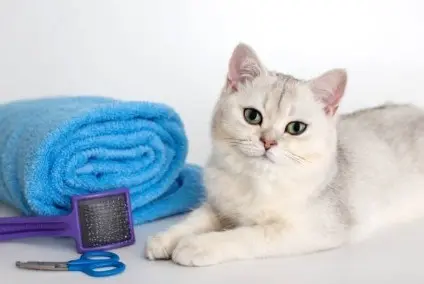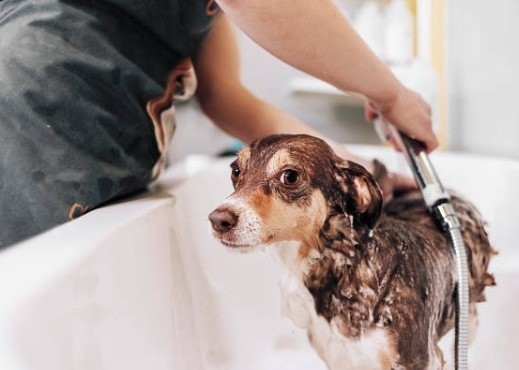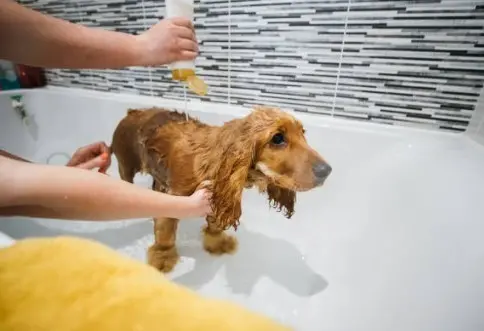Rub-a-Dub DIY—Top Tips for Bathing Your Pet
Pet parents sometimes ask us about bathing their dog or cat. For some, this is a regular and easy task. For others, it can present a challenge. Here are a few ideas and tips to help make this process as stress-free and efficient for everyone involved.
Why do I need to give my pet a bath?
For dogs, periodic bathing helps maintain basic hygiene and cleanliness. Washing the skin and hair coat removes everything from dirt and grime (i.e., the mysterious funk your dog rolled on in the grass), to allergens, bacteria, and parasites. Bathing also removes dead hair and hydrates and nourishes the skin and coat, helping your dog feel more comfortable and less itchy.
Unlike dogs, cats are diligent self-groomers and need less bathing. However, you may need to bathe your cat if they have a skin condition (e.g., dermatitis, ringworm) or cannot adequately groom themselves because of debilitating arthritis, weakness, or obesity.
How often should I bathe my pet?
Bathing frequency will depend on your pet’s species, breed, coat length, and lifestyle. In general, moderate- to long-coated dogs should be bathed every four to six weeks, while short-haired breeds may go for months without a bath. Some cats can live their entire life without a formal bath, while some long-haired breeds (e.g., Persian) require routine care.
Owners of pets who require medicated baths should follow veterinary instructions. Elderly, incontinent, or debilitated pets may need spot-bathing daily.
What supplies do I need to bathe my pet?
Professional grooming services can conveniently ensure your pet is tidied up as necessary, but if they require only a bath, you can certainly take a DIY approach. Here’s what you’ll need:
- Safe area — While large dogs can be bathed outside in a kiddie-pool or indoors in a walk-in shower, a sink or utility tub is best for small dogs and cats—and your back. Ensure your pet can’t escape, and bathe cats indoors only. Use lukewarm to warm water.
- Non-slip floor or mat —Standing on a shower mat or textured surface can help your pet feel more secure and less anxious.
- Shampoo and conditioner — Have all your supplies ready before you bring in your pet. If your veterinarian has prescribed a medicated product, follow the label directions and dilute if necessary.
- Water sprayer or pitcher — Big dogs may be comfortable with a garden sprayer and hose, but high pressure jets can be painful or frightening to smaller or more timid breeds. Use a water pitcher for petite or anxious pets.
- Cotton balls and ear cleaner — Place cotton balls in each of your pet’s ears to keep out water during the bath. Remember to remove them at the end!
- Restraint — If you are concerned that your pet may try to escape, restrain them with a grooming loop or a leash around their shoulder and under one arm (i.e., like a seatbelt). Never place the loop around your pet’s neck or leave them unsupervised.
- Towels and a dryer (optional) — Be prepared for the big finale with a stack of fluffy towels and—for tolerant pets—a cool-temperature (never hot!) hair dryer.
How can I keep my pet still during their bath?
Exercise your pet before bath time—take your dog for a walk or play with your cat and provide some one-on-one attention. If your pet is anxious or scared, try calming pheromone products such as Feliway or Adaptil. Or, preoccupy them with a tasty distraction—spread wet food, peanut butter, or spray cheese on a lickable mat that suctions to the bath tub or wall.

What’s the right way to give my pet a bath?
Once you have everything in place, and your pet is in the bathing area, follow these steps:
- Brush your pet — Brushing removes dead hair and eliminates mats and knots that will tighten with bathing and drying.
- Keep the ears dry — Place a cotton ball in each ear canal.
- Wet — Saturate your pet’s coat with lukewarm water, starting at the shoulders and moving toward the tail. Use a washcloth to clean the face and muzzle.
- Shampoo — Follow the application instructions, including any dilutions or set times, and lather your pet’s coat from the neck down.
- Rinse well — Poor rinsing can lead to dermatitis and itching, so rinse thoroughly—then, rinse again.
- Condition — If you use a conditioner, squeeze the water out of your pet’s coat and apply as directed, including any set times, to ensure proper moisturization.
- Rinse and rinse again — Unless you use a leave-in product, rinse until the water runs clear.
- Check those ears! — Remove the cotton balls and gently clean your pet’s ears with a veterinary-recommended cleaner that includes a drying agent.
How should I dry my pet?

Proper drying is key to preventing irritation and moist dermatitis (i.e., hot spots). Use towels to remove moisture from your pet’s coat. If it’s warm outside, take your dog for a walk and allow them to air-dry. If your pet is comfortable, use a hair dryer set on low and cool. Gently brush your pet to ensure their coat is mat and tangle-free.
Pet owners often describe bathing their pet as a chore, a struggle, or a rodeo. And while your pet’s s-paw day may never be described as “zen,” a little preparation, positivity, and patience can make the experience less stressful.
At UrgentVet, we understand all things pets—including that they don’t always stick to business hours where their health and safety are concerned. That’s why we’re here—for the grooming mishaps, ear infections, and minor injuries that happen after hours. For timely, caring, and affordable care, contact UrgentVet—because your pet can’t wait to feel better.






